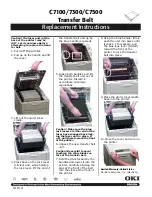
Programming
40
TTPM3 Printer/Encoder–Technical Manual
0705
4.6.7 Canceling a ticket
!F M
21 46 20 4D 20 n1...n8
Hex
33 70 32 77 32 n1...n8 Decimal
Format print on cancelled ticket
The TTPM3 can cancel a ticket after an unsuccessful magnetic encoding. The feature
relates to the read-after-write function
1
. When the <message> has been encoded, the
TTPM3 reads and compares the magnetically encoded message with the original
<message> string. If the comparison is negative, a second attempt to encode/read the
same ticket is done. If also this attempt is negative, the ticket is cancelled. The magnetic
stripe is erased and stripes are printed across the ticket (see figure below).
By default the TTPM3 attempts to encode three tickets. The desired number of attempts,
as well as the text used to indicate the cancellation, is programmable through a
subcommand to the !F command as follows:
!F M <orientation> <xpos> <ypos> <attempts> <height> <width> <font> <”text”>
All parameters must be specified.
The syntax is identical to !F T with the exception of the parameters <”text”> and
<attempts>.
Text
must be a text string.
Attempts
are the number of tickets the TTPM3 should attempt to encode. If <attempts> is
set to 1, the TTPM3 will make only one attempt (plus the automatic second attempt on
the same ticket) to encode the ticket. If this fails, <text> will be superimposed on the ticket
that is now being printed.
Setting <attempts> = 2 results is one striped ticket (first unsuccessful attempt) and the
superimposed text for the second unsuccessfully attempted ticket and so on.
Ir is also possible to set how many times the printer should try to verify each ticket by
adding a single digit after the !P command. This is described in the !P command
description.
All parameters in this command are stored in memory and remain in effect until
overwritten or the power is interrupted.
The following command string produces the tickets illustrated below at 2 unsuccessful
encoding attempts:
!F M N 20 200 2 8 8 1 "VOID"
1
Inserting an asterisk (*) in the data string to be encoded disables the read after write feature, see page 44.
















































